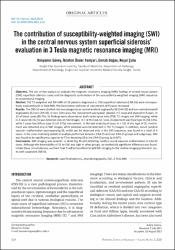The contribution of susceptibility-weighted imaging (SWI) in the central nervous system superficial siderosis’ evaluation in 3 Tesla magnetic resonance imaging (MRI)
Abstract
Objective. The aim of this study is to evaluate the magnetic resonance imaging (MRI) findings of central neural system (CNS) superficial siderosis cases and the diagnostic contribution of the susceptibility-weighted imaging (SWI) sequence to conventional imaging. Method. TSE T2-weighted and SWI-MRI of 26 patients diagnosed as CNS-superficial siderosis (CNS-SS) were retrospec-tively evaluated with 3-Tesla MRI. The localization and type of involvement of SS were reviewed. Results. The CNS-SS were divided into two categories as central amyloid angiopathy-SS (CAA-SS) and non-central amyloid angiopathy-SS (non-CAA-SS). In non-CAA cases, the involvement was typical (classic) in 5 cases and atypical in 9 cases. In 12 of these cases (85.7%), SS findings were observed on both turbo spine echo (TSE) T2 images and SWI imaging, while in 2 cases (14.3%) SS was detected only on SWI images. In 7 of the CAA-SS cases, involvement was focal type SS (58.33%), while 5 cases had diffuse type SS (41.67%) involvement. In the vast majority of cases (n = 10) of this type of SS, involvement was detected only in SWI images, while siderosis was not detected in TSE T2 images. In addition, occult cerebral vascular malformation accompanying SS, which can be observed only in the SWI sequence, was found in a total of 4 cases. In the cross-matching statistical analysis performed between CAA-SS and non-CAA-SS groups and subgroups, SWI was found to be significantly superior to T2 in detecting SS in the CAA-SS group (p:0,007). Conclusions. SWI imaging was superior in detecting SS and detecting cerebral occult vascular malformation in CAA-SS cases. Although the detectability of SS by SWI was high in other groups, no statistically significant difference was found. Under these circumstances, we think that it will be beneficial to add SWI imaging to the routine im


















